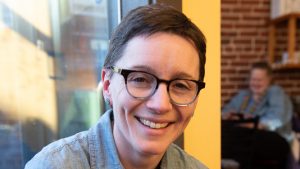Transitioning to Online: Reflections from a Faculty Member
Sarah Courchesne, professor of natural sciences, taught online for the first time in the spring, due to the pandemic. Courchesne values connecting with her students face-to-face, recruiting interns for her summer Great Black-backed Gulls Project on Appledore Island in Maine and often leading students on hikes in the White Mountains. After spending the summer transitioning her courses to online delivery, she reflects on the experience. Courchesne has a B.A. in English and a doctorate in veterinary medicine (DVM).
Teaching is a recurring sequence of goodbyes. The communities we build from scratch and tend over the course of fifteen weeks dissolve, and we go our separate ways. It ends abruptly even in a normal semester; it’s a simple fact that I will never see or hear from most of those students again.
Abrupt means sudden, but this spring, I found myself thinking of an older meaning of abrupt, which means “to separate, to pull away.” Teaching once we’d left campus felt like that. Somehow, we’d need to try and sustain our community without its structure, without a common place or time. Knowing my students would all be under massive strain, I did not require any real-time class meetings, shifting instead to a self-paced model of individual instruction and feedback between me and each student. They bore up well, kept apologizing to me for their (completely normal) loss of focus and motivation, learned as best they could. Over and over, I heard, “it’s not the same.” They finished the work, wrote self-reflection letters; I wrote back to each of them with gratitude and goodbye.
Summer was frenzied, flailing. I was preparing to teach fully online for my first time ever, and I didn’t know what to do. There was technical support, apps and programs that I could potentially employ, good instruction in how to make my materials universally accessible. We were offered many tools, but the best tools are flexible in purpose—you can use a hammer to join, to knock free, to pry apart. So many of the tools I learned about in summer were purpose built with a strict idea in mind—this one to capture your lecture, this one to deliver a virtual laboratory assignment—and I heard in my head my students’ voices saying “it’s not the same.” So many of the tools and techniques were aimed at keeping things the same, but replicating only the setting, the exams, the superficial trappings of education. But those weren’t the things my students lamented losing. They missed the community we’d built. Once I knew that, my plans for the fall crystallized. Everything organized itself around that single goal: to build a community, however atomized and dispersed we might be in time and space. It could not be built by me alone, ahead of time. Now, we are constructing it jointly as we go – the only way a community ever gets made.








